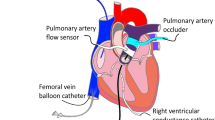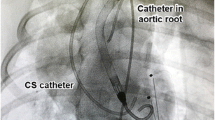Summary
Despite apparently depressed function, stunned myocardium maintains oxygen consumption and has the capacity to increase contractility with inotropic stimulation. We hypothesized that during stunning, O2 demand is maintained because regional segment work is performed, but is asynchronous with global left ventricular contraction, and that inotropic stimulation would restore regional work and synchrony. Thirteen open-chest anesthetized dogs were subjected to three left anterior descending (LAD) coronary artery occlusions (10 min) and reperfusions (15 min) to produce regional myocardial stunning. Segment shortening and force development were measured independently and simultaneously in the LAD (experimental) region and circumflex (control) regions. Regional myocardial work was calculated as the integrated product of instantaneous force and shortening, during two periods: 1) over the entire cardiac cycle (Positive Work), and 2) limited to the systolic portion of the cardiac cycle (Systolic Work). Regional myocardial O2 consumption (MVO2) was calculated from regional blood flow (radiolabeled microspheres) and O2 saturation data (microspectrophotometry). Occlusion of the LAD produced a delay in onset of segment shortening in the ischemic region, but not in regional force development. A time delay of 67–81 ms persisted through the three stages of occlusions and reperfusion. Systolic regional work was depressed to a greater extent (924±182 to 149±118 g*mm*min−1) than total positive regional work (1437±337 to 857±174 g*mm*min−1). Regional subepicardial MVO2 in the stunned region was not different than in the control region (7.3±1.5 vs. 6.9±1.4 ml O2*min−1*100 g−1). Local infusion of isoproterenol reversed the delay in regional shortening from 73±7 to 21±8 ms, thereby augmenting systolic work (298%) more than positive work (60%), without a significant increase in MVO2 (7.3±1.5 to 10.5±3.2 ml O2*min−1*100 g−1). It is concluded that myocardial stunning decreases regional systolic work due to regional mechanical asynchrony, while MVO2 is used supported total positive work which was not significantly reduced. Isoproterenol restores regional work by restoring synchrony, without greatly affecting regional MVO2.
Similar content being viewed by others
References
Acad B, Weiss HR (1989) Regional O2 consumption and coronary flow during beta adrenoceptor stimulation in reperfused canine myocardium. J Pharmacol Exp Ther 250:611–6
Ambrosio G, Jacobus W, Bergman CA, Weisman HF, Becker LC (1987) Preserved high energy phosphate metabolic reserve in globally “stunned” hearts despite reduction of basal ATP content and contractility. J Mol Cell Cardiol 219:953–64
Becker LC, Levine JH, DiPaula AF, Guarnieri T, Aversano T (1986) Reversal of dysfunction in postischemic stunned myocardium by epinephrine and postextrasystolic potentiation. J Am Coll Cardiol 7:580–9
Berne RM, Levy MN (1993) Physiology, p. 408, 3rd Ed., Mosby Year Book, St. Louis
Bolli R, Zhu W, Thornby JI, O'Neill PG, Roberts R (1988) Time course and determinants of recovery of function after reversible ischemia in conscious dogs. Am J Physiol 254:H102–14
Bolli R, Zhu W, Myers ML, Hartley CJ, Roberts R (1985) Beta-adrenergic stimulation reverses postischemic myocardial dysfunction without producing subsequent functional deterioration. Am J Cardiol 56:964–8
Boniface KJ, Brodie OJ, Walton RP (1953) Resistance strain gauge arches for direct measurement of heart contractile force in animals. Proc Soc Exp Biol Med 84:263(6)
Braunwald E, Sarnoff SJ, Case RB, Stainsby WN, Welch GH (1958) Hemodynamic determinants of coronary flow: effect of changes in aortic pressure and cardiac output on the relationship between myocardial oxygen consumption and coronary flow. Am J Physiol 192:157–63
Braunwald E, Kloner RA (1982) The stunned myocardium: prolonged, postischemic ventricular dysfunction. Circ 66:1146–9
Charlat ML, O'Neill PG, Hartley CJ, Roberts R, Bolli R (1989) Prolonged abnormalities of left ventricular diastolic wall thinning in the “stunned” myocardium in conscious dogs: time course and relation to systolic function. J Am Coll Cardiol 13:185–94
Ciuffo AA, Ouyang P, Becker LC, Levin L, Weisfeldt ML (1985) Reduction of sympathetic inotropic response after ischemia in dogs: contributor to stunned myocardium. J Clin Invest 75:1504–9
Dean EN, Shlafer M, Nicklas JM (1990) The oxygen consumption paradox of “stunned myocardium” in dogs. Basic Res Cardiol 85:120–31
Ellis SG, Wynne J, Braunwald E, Henschke CI, Sandor T, Kloner RA (1984) Response of reperfusion-salvaged, stunned myocardium to inotropic stimulation. Am Heart J 107:13–9
Ito BR, Tate H, Kobayashi M, Schaper W (1987) Reversibly injured, postischemic canine myocardium retains normal contractile reserve. Circ Res 61:834–6
Joselevitz-Goldman J, Upsher ME, Weiss HR (1987) Effects of propranolol on regional O2 supply and O2 consumption in reperfused dog myocardium. J Pharmacol Exp Ther 242:102–7
Kedem J, Sonn J, Scheinowitz M., Weiss HR (1989) Relationship between local O2 consumption and local and external cardiac work: Effect of tachycardia. Cardiovasc. Res. 23:1043–1052
Kedem J, Scholz PM, Weiss HR (1991) Augmented Efficiency of Regional Myocardial Work by Ouabain. Cardiovasc. Res. 25:916–922
Kedem J, Sonn J, Scheinowitz M, Weiss HR (1992) Effect of isoproterenol on regional myocardial segment work, O2 consumption and oxygen balance. Res Exp Med 192:323–334
Kedem J, Lee W, Weiss HR (1993) An experimental technique for quantitative determination of regional myocardial segment workin vivo. In press Ann Biomed Eng 1993
Krukenkamp IB, Silverman NA, Sorlie D, Pridjian A, Feinberg H, Levitsky S (1986) Characterization of postischemic myocardial oxygen utilization. Circulation 74 (suppl III):111–125
Kusuoka H, Porterfield JK, Weisman HF, Weisfeldt ML, Marban E (1987) Pathophysiology and pathogenesis of stunned myocardium: depressed Ca2+ activation of contraction as a consequence of reperfusion-induced cellular calcium overload in ferret hearts. J Clin Invest 79:950–61
Laster SB, Becker LC, Ambrosio G, Jacobus WE (1989) Reduced aerobic metabolic efficiency in globally “stunned” myocardium. J Mol Cell Cardiol 21:419–426
Laxon DD, Homans DC, Dai X, Sublett E, Bache RJ (1989) Oxygen consumption and coronary reactivity in postischemic myocardium. Circ Res 64:9(20)
Lewinter MM, Kent RS, Kroener JM, Carew TE, Covell JW (1975) Regional differences in myocardial performance in the left ventricle of the dog. Cir Res 37:191–9
Liedtke AJ, DeMaison L, Eggleston AM, Cohen LM, Nellis SH (1988) Changes in substrate metabolism and effects of excess fatty acids in reperfused myocardium. Circ Res 62:535–62
Mercier JC, Lando U, Kanmatsuse K, Ninomiya K, Meerbaum S, Fishbein MC, Swan HJC, Ganz W (1982) Divergent effects of inotropic stimulation on the ischemic and severely depressed reperfused myocardium. Circ 66:397–400
Przyklenk K, Patel B, Kloner RA (1987) Diastolic abnormalities of postischemic “stunned” myocardium. Am J Cardiol 60:12–3
Sinha A, Neubauer JA, Lipp JA, Weiss HR (1975) Oxygen saturation determination in frozen blood. Microvasc Res 10:312–21
Sinha A, Neubauer JA, Lipp JA, Weiss HR (1977) Blood O2 saturation determination in frozen tissue. Microvasc Res 14:133–44
Stahl LD, Weiss HR, Becker LC (1988) Myocardial oxygen consumption, oxygen supply/demand heterogeneity, and microvascular patency in regionally stunned myocardium. Circ 77:865–72
Upsher ME, Joselevitz-Goldman J, Weiss HR (1988) Effect of reperfusion on O2 supply/consumption balance in ischemic canine left ventricle. Res Exp Med 188:377–90
Weiss HR, Sinha AK (1978) Regional oxygen saturation of small arteries and veins in the canine myocardium. Circ Res 42:119–26
Author information
Authors and Affiliations
Additional information
This study was supported in part by a research grant from the Schulz Foundation and USPHS grant HL40320.
Rights and permissions
About this article
Cite this article
Chiu, W.C., Kedem, J., Scholz, P.M. et al. Regional asynchrony of segmental contraction may explain the “oxygen consumption paradox” in stunned myocardium. Basic Res Cardiol 89, 149–162 (1994). https://doi.org/10.1007/BF00788734
Received:
Accepted:
Issue Date:
DOI: https://doi.org/10.1007/BF00788734




